Chronicle of space super heavyweight. Part 3. "Marstodont" new era
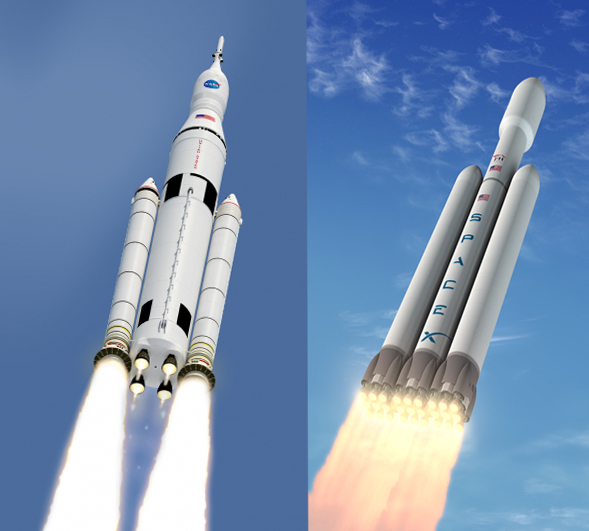
In 1984, NASA became clear that the Space Shuttle system was not able to carry out the planned 20 annual launches declared in the original project. The search for alternative solutions led to the first works on the creation of more budget options for the space system.
The disaster of the Challenger Shuttle in 1986 became the catalyst for the beginning of the transformation of this universal system, albeit only on the drawings, into a super-heavy lunar rocket.
As we know from the previous part of the review, the Orbiter space shuttle, using its RS 25 main engines, used an external fuel tank in the main part of the space system acceleration. Due to this, the Orbiter weighing about 100 tons went into Earth orbit. We also know from the experience of Soviet engineers who converted the reusable OS 120 system (technical copy of the Shuttle) to Eneria-Buran that such a scheme basically allows the reusable system to be converted into an extra heavy booster at relatively low costs.
')
The start of designing a super-heavy Shuttle C launch vehicle in October 1987 was the first step in that direction.
In fact, it was practically the same system, but only 3 marching (RS 25) and 2 shunting (OMS) engines remained from Orbiter, the released weight allowed the Shuttle C PH to bring up to 77 tons of payload to near-earth orbit. Thus, NASA hoped to cover a one-year plan for launching space shuttles (which would output no more than 25 tons at a time), as well as use a new carrier for launching large-sized orbital stations and large optical telescopes.
Scheme PH "Shuttle C", on the right a large-sized model of the upper stage C
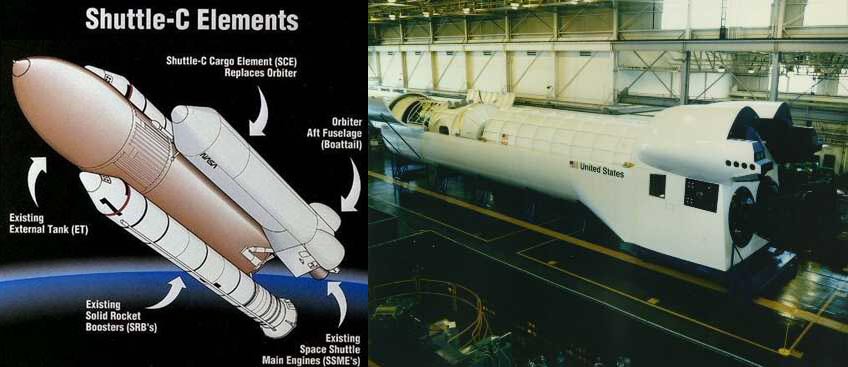
The cost of the entire scope of work was estimated at $ 2 billion, which was approximately equal to the cost of the new Orbiter. By the early 90s, despite this relatively low amount, NASA could not decide on the goals for the new promising RN. 2 billion was spent on the new orbiter Endeavor, and in the construction of orbital stations it was decided to rely on the help and experience of Russia (Mir-Atlantis, MKS). The project "Shuttle C" in 1995 was postponed to the far box. As it turned out, not for long.
In 2003, the world was shocked by another cosmic catastrophe. On returning to Earth with the ship Colombia, his entire crew of 7 astronauts was killed. Ironically, it was this shuttle that was proposed at the end of the 80s to be remade into the second stage of the Shuttle C PH. The leadership of the United States and NASA, it became apparent that the era of the Shuttle coming to an end earlier than they expected. It was decided to rethink not only the technical but also the ideological strategy of the American cosmonautics.
This resulted in an ambitious program "Constellation", announced in 2004. Within the framework of this program, it was supposed to use the Space Shuttle program again, but unlike Shuttle C, the power of solid-propellant rocket boosters significantly increased (the thrust of both accelerators was increased to 1,700 tons each). The TRU blocks were separated after 116 s after the start. The external fuel tank was increased in diameter from 8 to 10 m, and 3 of the main engines of the RS 25 were replaced with 5 simpler RS 68 from the Delta PH 4 (350t each), which were already transferred under the fuel tank itself (by analogy with the block Ts RN "Energy" ). After 303 seconds of work, the above-described first stage of the PH was separated, after which the second stage armed with the J 2X engine (modification of the second and third stage engine of the Saturn 5 PH) was put into near-earth orbit along with the lunar module Altair.
PH "Ares 5" with the lunar module Altair

The super heavy RN was named Ares 5, the name “Ares” meant the main goal of this RN - a manned expedition to Mars (the Romans called Mars the Greek god of war Ares). A figure 5 sent to the famous lunar rocket Saturn 5. Ares 5 was able to put 188 tons of payload into low earth orbit (or more than 70 tons into the moon's orbit).
In parallel, the heavy Ares 1 PH was used, the first stage of which was one TRU (SRB) PH Ares 5 block, and the second stage was also armed with a J 2X engine. Ares 1 launched the Orion manned spacecraft into orbit, which, after docking with the Altair lunar module, accelerated to the Moon’s second flight trajectory with the second stage of the PH Ares 5. The name of the rocket also sends an index to the Saturn 1 / B PH, which was used to launch manned spacecraft "Apollo" in the 60-70s.
Device PH "Ares 1"

Test launch RN "Ares 1", 2009. The closure of this project forced NASA to use the Russian Soyuz spacecraft to deliver astronauts to the ISS.
In 2009, the concept of the development of the project “Shuttle C” (renamed HLLV) was again proposed, some modifications of which made it possible to launch about 100 tons into Earth orbit)

However, NASA rejected this project, and a year later - in 2010, at the peak of the global financial crisis, the “Creation” program was also canceled.
In 2011, on the basis of the Constellation project, it was decided to create a more “trimmed” version of both the most heavy Ares 5 rocket and the Orion manned spacecraft.
The new SLS (Space Launch System) “Space Launch System” was much less different from the basic “Space Shuttle” system than the Ares 5. Thus, the 5th segment was added to the 4 original TRU sections. The parameters of the external fuel tank remained virtually the same (8.4 m in diameter). By analogy with the central unit "Energy" instead of three sustainer engines, 4 RS 25D / E engines were installed under the original shuttle fuel tank. However, in contrast to the “Energy” and “Shuttle C”, the output load was placed at the top, not at the side. The payload was the same 70t (Block 1) as the “Shuttle C”. The PH weight increased to 3000 tons, the height amounted to 121 m, the total thrust at the start was 4000 tons (3200 tons of thrust in the sum of two TRU units + 740 tons of thrust 4x RS 25). Such an excess of thrust with respect to the output load (even with the 130-ton version of Block 2) is explained by the very low specific impulse of the TRU blocks (265c).
Scheme PH "SLS" block 1
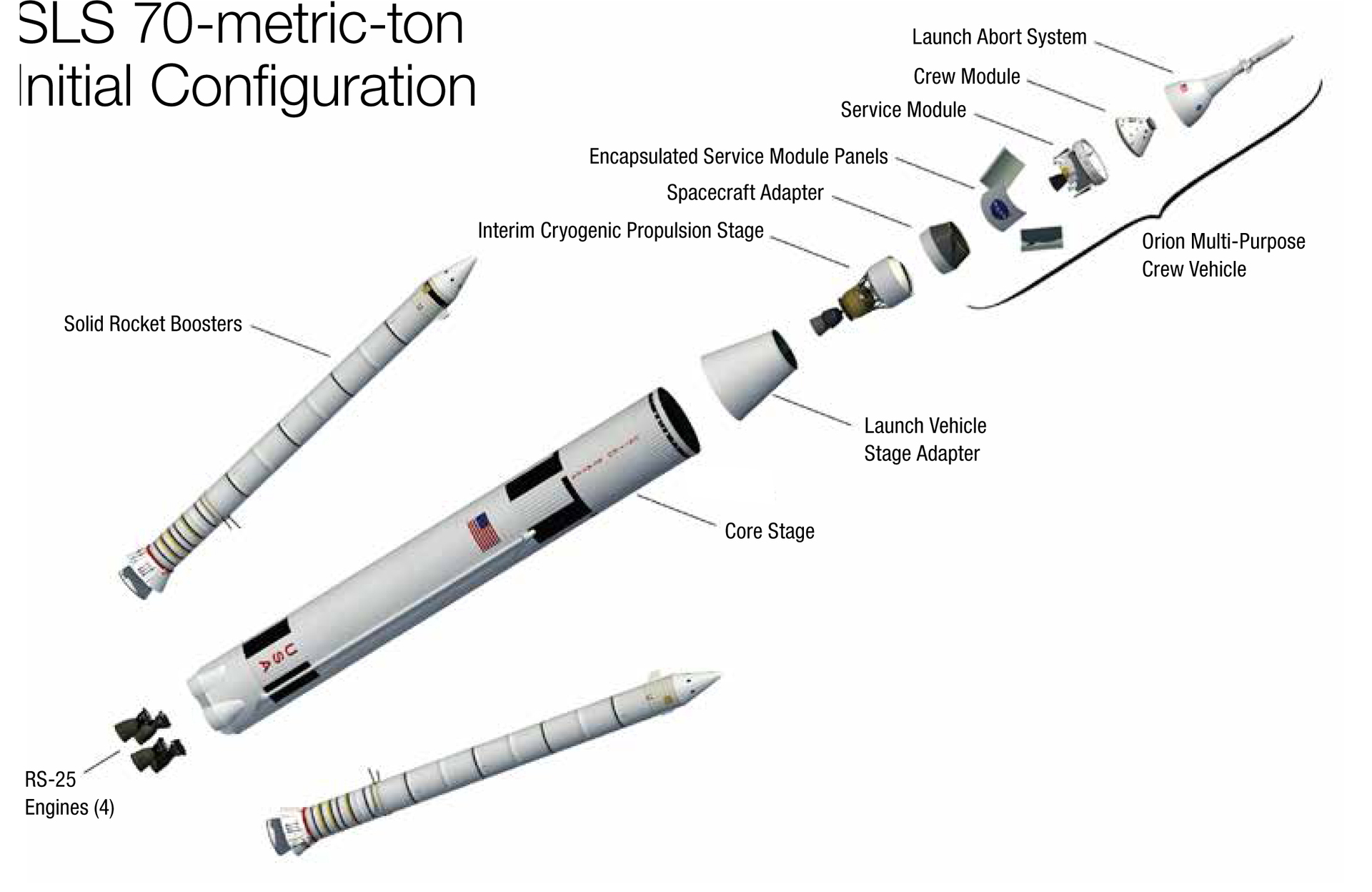
In the future, it is planned to strengthen the SLS to 105 (Block 1A) and 130 tons (Block 2), respectively, to carry out first lunar and then interplanetary manned expeditions. The cost of the project by 2017 is estimated at $ 35 billion. The readiness of the SLS SL is estimated at 70%, the first flight is scheduled for 2017.
Various variants of the SLS

Another historical curiosity. NASA has announced a tender for the purchase of promising LPRE engines for future versions of the SLS (in particular, Block 2), due to the aforementioned low y. pulse blocks TRU. Along with the Rocketdyne offer of a modified version of the F 1 engines of the Saturn 5 rocket (F 1B with an increased load from 690 to 800 tons), the private space company Aerojet with AJ 26 engines took up the fight. The AJ 26 is an American engine modification ... NK 33, developed at one time for the Soviet lunar rocket N 1. The tender ends next year, and the new duel of old rivals for a place in the new lunar rocket promises to be hot. However, it is possible that NASA will adopt both engines.
Concept F 1B (left) and NK 33 / AJ 26 on Aerojet test bench (right)
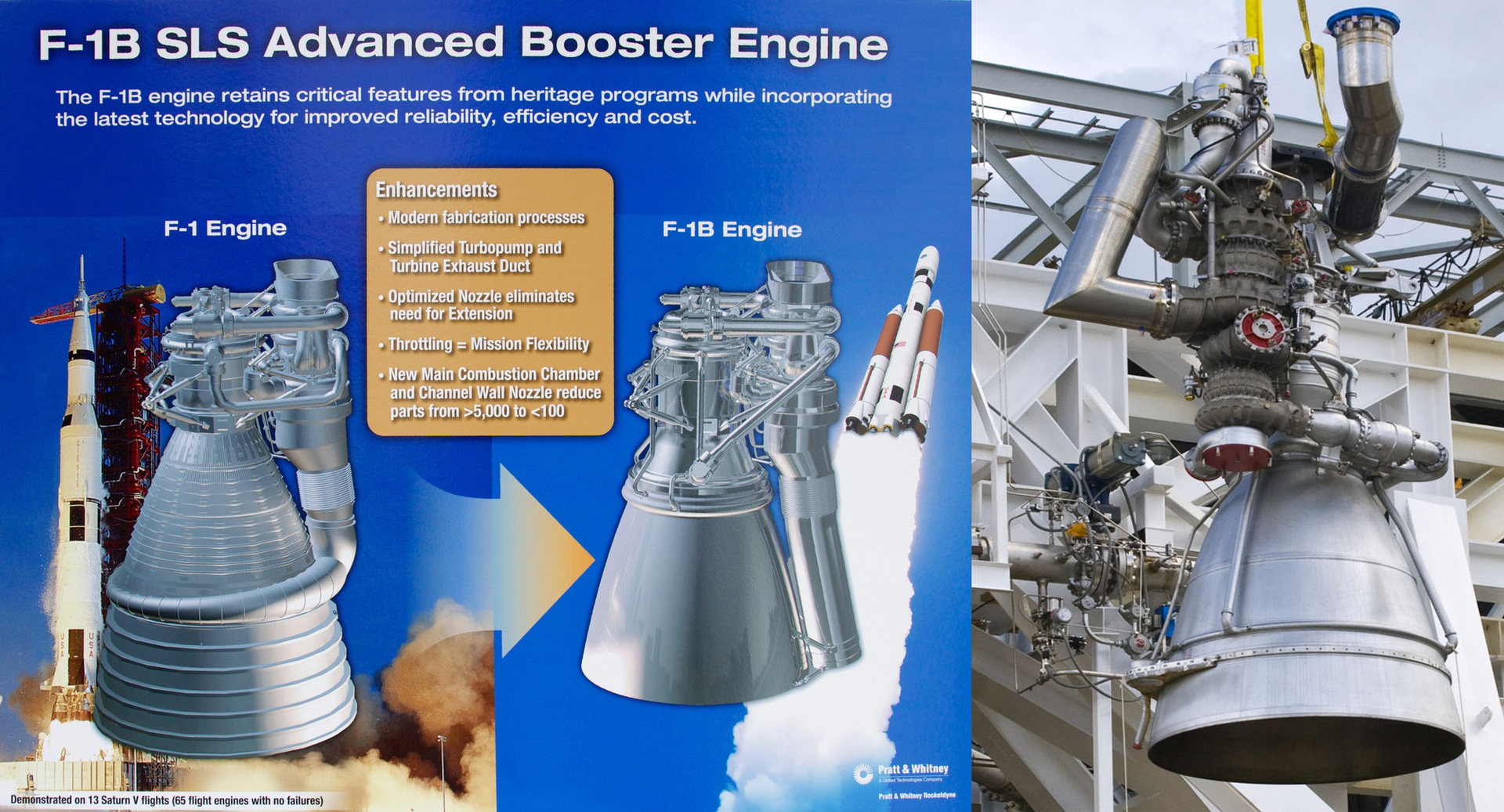
In the year of the closing of the program “Constellation”, on June 4, 2010, the private company Space X, founded by Ilon Mask, launched the enhanced version of the Falcon series rocket “Falcon 9”. Despite the fact that even a modified version of Falcon 9 1.1 did not allow outputting a payload weighing more than 14 tons (slightly less than the Zenit PH), in 2012 Space X announced the signing of a contract with the US Department of Defense on the launch of the super-heavy version Falcon Heavy »In 2015
Ilon Musk on the background of the Falcon 9 1.0 PH. Clearly visible 9 Merlin 1C engines located in a “square”

For this purpose, the package scheme of the rocket design with three Falcon 9 1.1 blocks for the first and second stages, armed with 9 Merlin 1D reinforced engines each, is used. The third stage, armed with one Merlin 1D engine, is used to accelerate cargo into Earth orbit (5 in the diagram below). A total of 27 engines at the start develop traction in 1800 tons at . pulse in 282s. The diameter of each unit is 3.6 m, the height of the rocket is 68 m, the weight is 1460 tons, the mass of the output payload to a low near-earth orbit is 53 tons, with a launch price of 100 million dollars. In the future, it is planned to reuse first-stage blocks
The Falcon Heavy PH scheme, three modules of the first stage of the Falcon 9 1.1 PH, has 9 Merlin 1D engines (bottom right) each. The characteristic “circular” arrangement of the main engines of the Falcon 9 1.1 PH
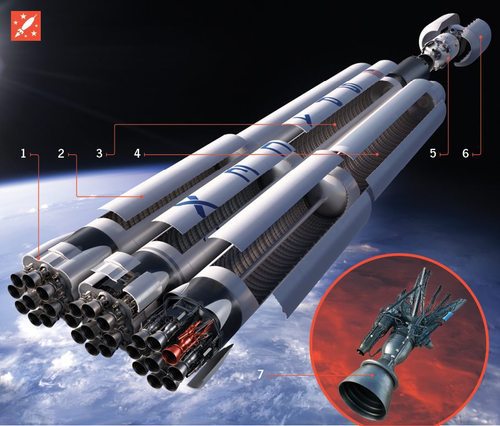
According to the plans of Space X, the main goal of creating this carrier is to demonstrate low-cost means to carry out a manned expedition to Mars ( the Red Dragon and Mars One programs ).
The modular “counterpart” of the Falcon family of rocket engines - the Russian Angara launch system developed by RSC Energia and NPO Energomash, is also theoretically capable of launching cargo of up to 50 tons into orbit. The A7,2V version of the rocket is completed with 6 basic and one reinforced URM 1 units armed with RD 191 engines each. 7 engines must develop a total thrust at the start in 1400t. For acceleration of the payload to the Earth's orbit, a block of the third stage KVTK2 with the engine rd 0124 is used. The mass of the design RN is 1200 t, height - 65 m. However, even for the “Angar A7” version with a lifting capacity of 35t, it will be necessary to build a separate launching table, and in the next 10 years, assemblies A1 to A5 with a loading capacity from 1.5 to 25t will be mainly used.
Various compositions of blocks URM 1 PH "Angara"
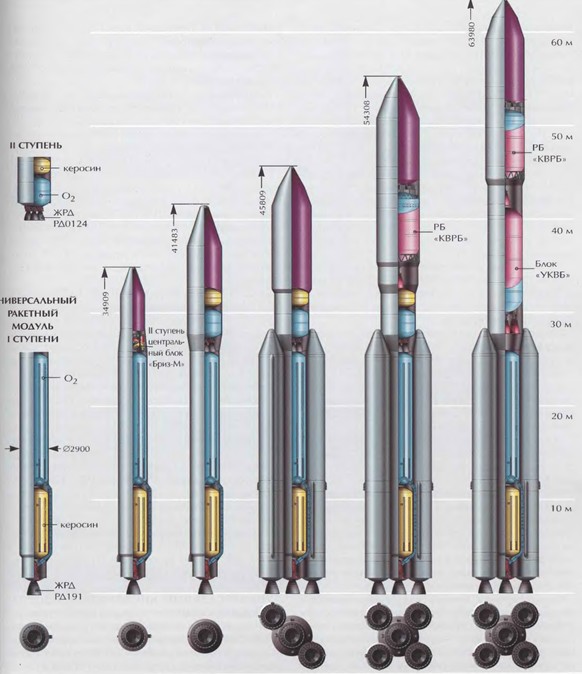

Projects of a separate super heavy RN are in their infancy in Russia. Although our country has all the necessary means for this (family of light (RD 191 / NK 33) and heavy (RD 171 / M) highly efficient engines), there is no specific task for such a RN yet. However, things can quickly change not only against the background of the success of the American projects SLS and Falcon Heavy, but also the work in this direction of our eastern neighbors.
The hypothetical version of the super-heavy Russian LV “Yenisei 5” borrows in many respects the developments on the Energia rocket, namely 4 upper stage upper stage units with RD 170 engines and second stage hydrogen engines RD 0120 (recovery of the latter’s production remains a big question

In China since 2013, the future super-heavy carrier “Great March 9” is at the design stage of work. Chinese engineers are actively developing the YF 660 oxygen / kerosene engines with a 650-ton starting weight. Four of these are planned to be used at the first stage of the PH (or 4 TRU blocks with a 1000-tonne each).
Technological layout of the experimental engine YF 650 (left) and the diagram of the engine YF 220 (right)

The second stage will also be armed with x4 YF 660 (version A) or x5 YF 220 (version B), and the third with two (version A) or one (version B) engines of YF 220 with 200 tons. The mass of the rocket is estimated to be 4000 tons, the thrust at the start is 5000 tons, the length is 100 meters, and the payload is 130 tons. The main task of the new RN is the beginning of human colonization of our natural satellite, the Moon.
PH "Great campaign 9", version A (left) and B (right)

It remains only to wish good luck to all participants of the new race of super-heavy carriers, and hopes that this time the great journey of man into space will be the beginning of a full-scale human exploration of the solar system.
Part 1. Moon "dinosaurs".
Part 2. "Park" reusable period.
Source: https://habr.com/ru/post/229519/
All Articles